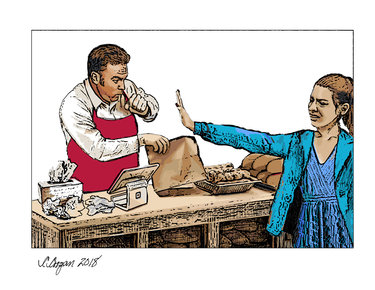Providing employees paid sick leave shows a healthy self-interest
The Enterprise is a small business. An independent weekly newspaper, we have only six employees: three full-time reporters, two part-time office workers, and a part-time salesperson. So we could understand the local business owners who spoke out at last week’s public hearing at the Albany County Legislature against a bill that would require paid sick leave.
Susan Novotny, owner of The Book House of Stuyvesant Plaza, told the lawmakers they could look at her records. We know independent booksellers, just like newspapers, are hurting in this internet age.
Similarly, Robert Abbruzzese, whose family owns Altamont Orchards, spoke of how the golf course there, like others in the area, are suffering. He spoke against the bill, too.
But we’re for the bill. We already offer paid sick- and personal-leave days. Here’s why.
We value our workers and believe they do a better job when they are healthy. They, in turn, are loyal to our paper and do outstanding work.
Staff turnover is reduced and productivity increases when workers have paid sick leave. According to a Commonwealth Fund study completed back in 2005, fifty-five million workers reported a time when they were unable to concentrate at work because of their own illness or that of a family member, accounting for 478 million days. According to the analysis, “Workers without paid time off to see a physician are more likely to report missing work or being unable to concentrate at their job.”
“Presenteeism,” a relatively new term, describes a phenomenon that is, in some ways, the opposite of absenteeism. It refers to employees feeling compelled to work even when they are sick. A study published in the Journal of Occupational and Environmental Medicine found that presenteeism costs were higher than medical costs in most cases. In other words, employers lose more through the lower productivity of sick workers than they would in paying for their medical care.
“A majority of working adults say they still go to work when they are sick,” according to a 2016 study from the Harvard School of Public Health. “Half of restaurant workers and more than half of workers in medical jobs say they still go to work always or most of the time when they have a cold or the flu. Many workers have also had experiences in caring for family members who were seriously ill, injured, or disabled while working at their current job.”
Workers in medical facilities and at restaurants, of course, have jobs that would allow them to spread their illnesses to a wide variety of patients or customers. A 2009 study by the Center for Economic and Policy Research called “Contagion Nation: A Comparison of Paid Sick Day Policies in 22 Countries,” states: “In health care and service settings, providing paid sick days to employees also helps to protect the health of patients and customers. For example, nursing homes that provide their employees with paid sick days have lower rates of respiratory and gastrointestinal illness among the patients they serve.”
“Contagion Nation” also states, “Conservatively estimated, at least 20 million Americans go to work sick because of a lack of sick leave.” The report concludes, “We reviewed paid-sick-day and paid-sick-leave policies in 22 countries ranked highly in terms of economic and human development and find that the United States is the only country that does not guarantee that workers receive paid sick days or paid sick leave. Current U.S. labor law does not require employers to provide short-term paid sick days or longer-term paid sick leave; current U.S. law does not even protect all workers from being fired when they miss work due to illness.”
The president of the Albany Chamber of Commerce, Mark Eagan, told our reporter Sean Mulkerrin last week that issues like paid sick leave need to be dealt with at the federal level. We agree that would be best but we don’t see that happening anytime soon under the current administration.
In the meantime, the argument that businesses would fail in or leave Albany County if the law were adopted we believe is untrue. New York City passed an earned-sick-time law that took effect in 2014, covering about 3.9 million workers, including 1.4 million who had not had access to paid sick leave before.
A study by the Center for Economic and Policy Research in 2015 and 2016 found “the vast majority of employers responding to our survey (almost 85 percent) reported that the new law had no effect on their overall business costs.” Rather than leading to a loss of jobs as critics had predicted, jobs increased.
We believe, as does one of the sponsors of the Albany County bill, Democrat Samuel Fein, that government should protect workers — minimum wage, overtime pay, and child labor laws are all examples of government protecting workers because some businesses would not.
Fein’s Albany district has many low-income residents, people who, he says, are struggling and they support the bill and would be helped by its passage. He also notes that the Black Chamber of Commerce supports the bill because it cares about both business and community.
According to a study cited in the bill, up to 40 percent of Albany County workers lack access to paid sick leave. The disparity more pronounced among workers in low-wage jobs, according to the American Public Health Association.
We believe, based on the research cited here, that the county’s economy would be more robust if those workers had access to paid sick leave. When sick or injured, they would return to work more quickly and be more productive. And, they would not spread disease to co-workers, customers, or patients, improving the health of the community.
“Influenza-like disease rates decrease after employees gain access to paid sick leave,” according to a 2016 paper from the National Bureau of Economic Research. States and cities that require paid sick leave have fewer flu cases than comparable states and cities.
“Lack of paid sick leave can have substantial adverse consequences for public health, including the spread of infectious disease,” says a 2013 study by the American Public Health Association. “During the 2009–2010 H1N1 pandemic alone, an estimated 7 million additional individuals were infected and 1,500 deaths occurred because contagious employees did not stay home from work to recover,” it says.
Often our legislators have to choose between what is right for the constituents they serve — ensuring life, liberty, and the pursuit of happiness — and what is economically expedient. But in this case, doing the right thing, particularly for low-income workers who can’t afford to miss work, is also the economically expedient choice.
What if Albany County were known as the Compassionate County, attracting businesses and workers who could see the value of both physical and economic health?
We would no longer need to listen to the heartbreaking stories of workers like Elizabeth James who told legislators at last week’s public hearing, as she held her sleeping baby in her arms, how she lost her job last year when she missed a week of work because she was sick with flu, and her children were, too.
“Getting sick is not something you can ever plan for,” she said. She’s right, a worker can’t. But a business can plan for that worker to get the paid time she needs to heal. It can be a matter of life and death — for all of us.

